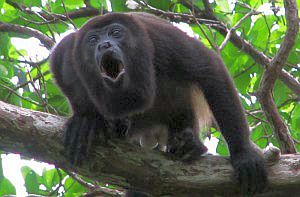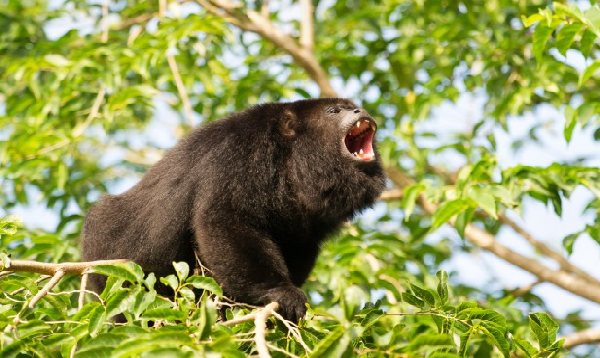Because of human disturbance to its habitat, the endangered Mexican howler monkey is consuming more leaves and less fruit. This change in diet is forcing them to invest much more time foraging for nutrition. Hormone analysis reveals that this is leading to increased stress levels in the monkeys.
The findings of this study, led by the University of Cambridge, were published in a recent issue of International Journal of Primatology. The research was carried out in the field, in the tropical rainforests of the Mexican state of Veracruz. The rainforests of Veracruz are being deforested and fragmented by human activity, such as clearing the forest for cattle. The increase in howler monkey "travel time" – the time needed to find the required nourishment – leads to higher levels of stress hormones called glucocorticoids.
Glucocorticoids are not only indicators of stress, but are also known to relate to diminished reproductive success and lower survival rates. The scientists believe that the study could serve as a behavioral change and resulting health implications model for primates in general living in habitats disturbed by human activities like deforestation.
"Howlers are arboreal primates, that is to say they spend their wholes lives in the trees", said Dr. Jacob Dunn from Cambridge’s Department of Biological Anthropology. "As forests are fragmented, the howlers become cut off, isolated on forest ‘islands’ that increasingly lack the fruit which provide an important component of their natural diet. This has led to the monkeys expending ever more time and effort foraging for food, often increasing leaf consumption when their search is, quite literally, fruitless."
Because fruit occurs in natural cycles, the monkeys will naturally revert to "fallback" foods, including leaves, when the fruit is scarce. Fruit is harder to find, however, as habitats shrink, increasing the need for leaves from second-choice plants such as lianas in the Mexican howlers’ diet.
 |
In a rainforest, leaves might sound like a plentiful food source. However, many leaves are difficult to digest and can be filled with toxins, which is a natural defense mechanism in most trees and plants. This forces the monkeys to spend more time seeking out the right foliage to eat, such as new shoots, which are generally less toxic. "The traditional view was that the leaves exploited by howler monkeys were an abundant food source – but this is not the case," said Dunn.
"The monkeys rely much more heavily on fruit than previously believed, and when turning to foliage for food – as they are increasingly forced to do – they have to be highly selective in the leaves they consume, visiting lots of different trees. This leads to the increased ‘travel time’ and consequent high levels of stress we are seeing in these primates as their habitats disintegrate."
Trying to catch wild howlers would add to the stress of the animal, so the best way to evaluate hormone and stress levels in wild primates is by collecting and analyzing their feces for the glucocorticoid stress hormones. These are general to all primates. The researchers used statistical modeling to determine that it is the ‘travel time,’ rather than the increased foliage intake that is causing high levels of stress.
"Monkeys in disturbed habitats suffering high levels of stress is in itself unsurprising perhaps, but now we think we know why - the root cause from the primates perspective. Our results also highlight the importance of preserving and planting fruit trees – particularly those species such as figs that can produce fruit during periods of general fruit scarcity – for the conservation of howler monkeys," said Dr. Jurgi Cristóbal-Azkarate of Cambridge, who led the research in collaboration with Dr. Joaquim Vea from the University of Barcelona.


